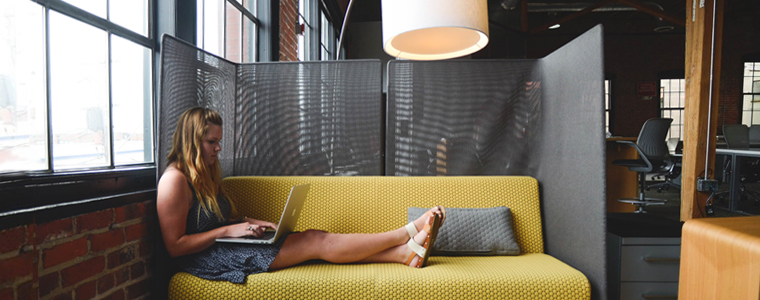When home sweet home is at work

by Raquel Baetz
Does the place where you work seem more like a living room than a workspace? If so, you’re not alone.
San Francisco-based software designer Zendesk has purposefully created a new headquarters that “blurs the line between home, hospitality and workplace, merging all the comforts and qualities of each.”
Many businesses and workspaces are following this trend, changing their physical environment to reflect a more home-like experience. Some of the perks are distinct rooms that accommodate different styles of working, spaces for fun and exercise, furniture for movement and relaxation, spots to rest and sleep, and free food and drink.
From the outside, these seem like places where someone might like to spend a good chunk of their day. In fact, it’s a wonder that anyone ever leaves. And that’s the problem.
These workspaces encourage people to spend increasing amounts of time at work, but is this healthy or even safe?
Is it good for the body?
Providing lots of choice for where to physically sit or stand at work – as these living-room workspaces often do – encourages occupants to get up and move. That’s great – moving is a good practice during the work day. But it’s not good if it comes at the expense of good ergonomic set up. Visit any website of one of these design-led workspaces and you’ll likely see images of people bent over a laptop, tablet or smartphone.
Now that we can carry our work in the palm of our hand, the temptation to use our digital devices everywhere is hard to resist. So occupants of these spaces continue to type, tap and scroll wherever they are: desk, conference table, kitchen banquet, sleep pod, tree house.
It’s difficult if not impossible to set up a digital workstation well when you’re working with a table that’s too low, a chair that’s designed for reclining, or any other non-ergonomic configuration.
But even when the tables and chairs are ergonomically-sound, they do no good if digital devices and the bodies operating them are being used in an unsafe way. Unsafe means laptop screens below eye level with heads and necks bent down.
It’s all right to do this once in a while for short periods of time, but do it all day long, day after day, and your body is going to start showing the signs of strain: neck ache, back pain, etc.
To use laptops and tablets safely, ergonomic accessories like laptop and tablet stands and detachable keyboards and mice are necessary. If you can’t afford the stands, do-it-yourself fixes, like raising laptop on a stack of books, work just as well.
These accessories should be made available on every work surface and occupants should be shown how to set up and use them well.
Standing desks are also a great way to encourage more movement, and many of these new workspaces have them. But standing desks are often used in an unsafe way. Just because you’re standing doesn’t make it OK to look down at your laptop.
Millennials are still young, so maybe they aren’t feeling the strain of all their bending and hunching yet. But ten years from now that neck ache may become a musculoskeletal injury that takes years to recover from.
Each time you perch somewhere new, set it up right. For tips, see our other articles by Raquel Baetz: What I wish I’d known before getting RSI and Coworking and repetitive strain injuries.
Is it good for the brain?
Now that we can keep working in any location, on any surface, in any position, for as long as we can keep our eyes open, the temptation to do so is proving impossible to resist. Making time to be off work and off screen is really important for your body but it’s also important for your brain.
So even though free beer after 6pm sounds like a great perk, you’ll likely end up mulling over work or scanning social media while you’re hanging out.
Once in a while this is fine, but according to neuroscientist Daniel Levitin in his book The Organized Mind, downtime helps our brains be effective when we really need them. This is why setting aside downtime is so crucial. It’s the reason you get your best ideas in the shower, because it’s one of the few times we aren’t inputting information into our brains. Here, your brain is free to go where it wants without the leash of distractions, especially from the on-line world.
Participating in non-work activities and non-work thinking, both during the work day and before and after it, is key. If it’s hard for you to break away, then plan for it. Schedule some time to disengage completely from work and screens.
Disengaging with work, even in very short bursts during the work day, improves energy levels. Taking a walk at lunch without your smartphone is a great example.
Regular breaks also help keep your mind sharp and improve creativity and productivity.
It’s great that design-led, living room workspaces are being created to increase productivity, collaboration and fun at work, but we shouldn’t underestimate the value of getting away from work and the workspace, both physically and mentally.